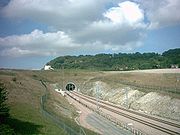
North Downs Tunnel
Encyclopedia

Tunnel
A tunnel is an underground passageway, completely enclosed except for openings for egress, commonly at each end.A tunnel may be for foot or vehicular road traffic, for rail traffic, or for a canal. Some tunnels are aqueducts to supply water for consumption or for hydroelectric stations or are sewers...
that carries High Speed 1 through the North Downs
North Downs
The North Downs are a ridge of chalk hills in south east England that stretch from Farnham in Surrey to the White Cliffs of Dover in Kent. The North Downs lie within two Areas of Outstanding Natural Beauty , the Surrey Hills and the Kent Downs...
, at Blue Bell Hill
Blue Bell Hill
Blue Bell Hill is a chalk hill between Maidstone and Rochester in the English county of Kent. It overlooks the River Medway and is part of the North Downs. Settlements on the hill include Walderslade; and Blue Bell Hill and Kit's Coty villages...
near Maidstone
Maidstone
Maidstone is the county town of Kent, England, south-east of London. The River Medway runs through the centre of the town linking Maidstone to Rochester and the Thames Estuary. Historically, the river was a source and route for much of the town's trade. Maidstone was the centre of the agricultural...
in Kent
Kent
Kent is a county in southeast England, and is one of the home counties. It borders East Sussex, Surrey and Greater London and has a defined boundary with Essex in the middle of the Thames Estuary. The ceremonial county boundaries of Kent include the shire county of Kent and the unitary borough of...
, south-east England
England
England is a country that is part of the United Kingdom. It shares land borders with Scotland to the north and Wales to the west; the Irish Sea is to the north west, the Celtic Sea to the south west, with the North Sea to the east and the English Channel to the south separating it from continental...
.
The tunnel was constructed by mechanical excavation of the weak chalk
Chalk
Chalk is a soft, white, porous sedimentary rock, a form of limestone composed of the mineral calcite. Calcite is calcium carbonate or CaCO3. It forms under reasonably deep marine conditions from the gradual accumulation of minute calcite plates shed from micro-organisms called coccolithophores....
, followed by application of a sprayed concrete lining (SCL
New Austrian Tunnelling method
The New Austrian Tunnelling method was developed between 1957 and 1965 in Austria. It was given its name in Salzburg in 1962 to distinguish it from old Austrian tunnelling approach. The main contributors to the development of NATM were Ladislaus von Rabcewicz, Leopold Müller and Franz Pacher...
), prior to construction of an in-situ reinforced concrete
Reinforced concrete
Reinforced concrete is concrete in which reinforcement bars , reinforcement grids, plates or fibers have been incorporated to strengthen the concrete in tension. It was invented by French gardener Joseph Monier in 1849 and patented in 1867. The term Ferro Concrete refers only to concrete that is...
secondary lining. Due to the environmental sensitivity of the area, no pressure relief shafts were provided.
It was completed in December 2001 as part of the first phase of the CTRL, £5 million under budget and five months ahead of schedule. Over 100 workers working in shifts 24 hours a day made this possible, despite the site being perceived as a major risk before the project.
The tunnel is 3.2 kilometres (2 mi) long, with an internal diameter of 12 metres (40 ft) and a cross-sectional area (CSA) of 150 square metres, and descends to a depth of 100 m below the chalk hills. This made it one of the largest (in terms of CSA) and deepest twin-track railway tunnels ever constructed in the UK.
Trains using High Speed 1 can reach speeds of 300 kilometres per hour (186 mph) but, for safety reasons, they will travel at a lower speed through the tunnel and across the Medway Viaduct
Medway Viaduct
There are three Medway Viaducts, two of which carry the two carriageways of the M2 motorway. The other viaduct carries High Speed 1 across the River Medway near Rochester in north Kent, England.-M2 Motorway viaduct :...
over the River Medway
River Medway
The River Medway, which is almost entirely in Kent, England, flows for from just inside the West Sussex border to the point where it enters the Thames Estuary....
.

